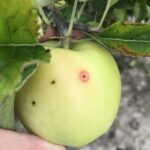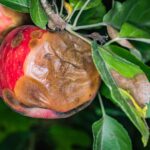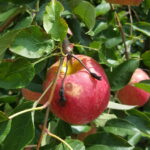With increasing rains and extremely hot weather, this is a reminder that bitter rot weather is in full swing (along with black rot, white rot, sooty blotch and flyspeck!). Caused by fungi in the genus Colletotrichum, bitter rot thrives during warm, wet conditions, especially weather events that maintain fruit wetness for 8-12 hours, due to extensive rainfall or extremely humid conditions (Fig. 1).
It is imperative to keep fruit covered, especially in those really susceptible varieties, like Honeycrisp, Gala, Empire, Rosalee, Cameo, Cripps’ Pink/Pink Lady, and to a lesser degree, Golden Delicious, Granny Smith, Ida Red, Ginger Gold, Braeburn—the list is extensive (Fig. 2)!
For those that have slacked off their cover sprays due to the proceeding drought, keep in mind that infection may have already occurred (latent infections), and fungicides are not going to ‘cure’ any of these latent infections—they simply protect against new infections. How long the fungus remains latent depends the cultivar, fruit ripeness, temperature and humidity. Symptoms manifest with the ripening fruit, and one of the most insidious things about bitter rot is how everything looks fantastic until harvest.
If you haven’t already and the weather has turned wet, tighten spray intervals, being sure to include:
- captan at 3 lb per acre (and an acidifier, if necessary, or a phosphorous acid fungicide) or
- ziram at 4 lbs per acre (14-day PHI).
- Remember that captan hydrolyzes when the tank mix pH exceeds pH 8.0—keeping it around pH 7.0 stabilizes captan to perform at its best. This will also control black rot, white rot, sooty blotch and flyspeck.
If powdery mildew is a problem, consider adding the following to your rotation:
- Flint Extra (FRAC 11; 14-day PHI)
- Luna Sensation (FRAC 7 + 11; 14-day PHI)
- Merivon (FRAC 7 + 11; 14-day PHI)
- Pristine (FRAC 7 + 11; 14-day PHI)
- Keep in mind that growers are limited to 4 applications of these fungicides per season, so plan wisely!
Other options with later PHIs include
- Aprovia (FRAC 7; 30-day PHI)
- Omega (FRAC 29; 28-day PHI)
- Sovran (FRAC 11; 30-day PHI)
- Sovran follows the caveats above. Aprovia provides very good control against bitter rot, but be careful with the use of Aprovia with other FRAC 7 containing fungicides!
We did have some luck switching out captan sprays with Parka Sunburn protection, protecting fruit from sunburn. Surprisingly, it didn’t leave a residue and when alternated with captan, reduced our overall use of captan significantly. It’s important to note the year we did this trial, we had low disease pressure (~30% infected untreated control trees), unlike previous years (over 60% infection on untreated control trees). In other words, your mileage may vary (YMMV). With the extreme heat, sunburn is going to predispose exposed fruit to bitter rot infection (Fig. 3).
Prior to harvest, an application of Merivon or Pristine improves fruit finish and suppresses bitter and other post-harvest rots.
Bitter rot is a manageable disease, as long as cover sprays remain in place. With so many losing their crop due to frost, those that have fruit need to step up their games in the coming wet weeks to protect it until harvest.
- Figure 1. Early bitter rot. Photo by Janna Beckerman.
- Figure 2. Late bitter rot infection. Photo by Janna Beckerman.
- Figure 3. Sunburn predisposes fruit to bitter rot infection. Photo shared by grower.


